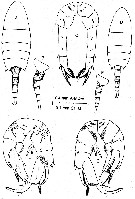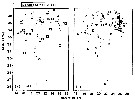|
|
 |
|
Calanoida ( Order ) |
|
|
|
Diaptomoidea ( Superfamily ) |
|
|
|
Pseudodiaptomidae ( Family ) |
|
|
|
Pseudodiaptomus ( Genus ) |
|
|
| |
Pseudodiaptomus colefaxi Bayly, 1966 (F,M) | |
| | | | | | | Syn.: | Pseudodiaptomus hickmani : Dakin & Colefax,1940;
Pseudodiaptomus sp1 Bayly,1965 | | | | Ref.: | | | Greenwood, 1977 (p.65); Dussart & Defaye, 1983 (p.34); Walter, 1986 (p.133); 1986 a (p.503); 1987 (p.368, 372, figs.F,M, Rem.); Bradford-Grieve,1999 b (p.151, figs.F,M, fig.181) |  issued from : T.C. Walter in Aust. J. Mar. Fresfw. Res., 1987, 38. [p.373, Fig.4]. Female: A, habitus (dorsal); B, last thoracic segment and urosome (lateral right side); C, P5 (posterior view). Male: D, habitus (dorsal); E, last thoracic segment and urosome (lateral right side); F, P5 (posterior view); G, idem (anterior view).
| | | | | Compl. Ref.: | | | Kimmerer & McKinnon, 1985 (p.149); Jacoby & Greenwood, 1988 (p.131, tab.1, 4, 5, 6, 7, 8, 10, fig.1); Greenwood & al., 2002 (p.17, Table 2, fig.2) | | | | NZ: | 1 | | |
|
Distribution map of Pseudodiaptomus colefaxi by geographical zones
|
| | |  Issued from : J.G. Greenwood in Estuar. Coast. Shelf Sci., 1981, 13. [p.593, Fig. 1, c, d). Issued from : J.G. Greenwood in Estuar. Coast. Shelf Sci., 1981, 13. [p.593, Fig. 1, c, d).
Salinity-temperature-dominance relationships in occurrences of two congeneric species pairs: Pseudodiaptomus colefaxi (a) and Pseudodiaptomus mertoni (b).
DS scale refers to grades of dominance (see methods).
This diagram is used to demonstrate differences in ecological requirments of the congenors.
Samples taken by sampling monthly over three years at several stations within the Moreton Bay estuarine system.
The existence of such closely related sympatric species is of great interest concerning interspecific competition and the notion of 'niche theory'. The principles of these topics are summarized by Whittaker (1975), Odum (1971). Possible ways in which zooplanctonic populations may avoid or reduce direct competition have been summatrized by Pejler (1962) as 1- spatial (e.g. by differing horizontal/or vertical distributions; 2- functional differences, e.g. by selective feeding preferences; 3- temporal differences by species populations reaching maxima at different times of the year; and other factors as predators or toxicity.
For the author (p.594), P. colefaxi has retained a more flexible gene pool while its congenitor P. mertoni has specialized and is more efficient towaed the upper end of both salinity and temperature ranges. |
| | | | Loc: | | | E Australia (Great Barrier Reef, Brisbane River estuary, Melbourne, Victoria: Westernport Bay) | | | | N: | 5 | | | | Lg.: | | | (863) F: 1,28-1,30; M: 1,12-1,15; {F: 1,28-1,30; M: 1,12-1,15} | | | | Rem.: | Surface plankton.
Incomplete data.
In Ramosus species group (serricaudatus subgroup) after Walter & al. 2006, p.203. | | | Last update : 05/12/2017 | |
|
|
 Any use of this site for a publication will be mentioned with the following reference : Any use of this site for a publication will be mentioned with the following reference :
Razouls C., Desreumaux N., Kouwenberg J. and de Bovée F., 2005-2025. - Biodiversity of Marine Planktonic Copepods (morphology, geographical distribution and biological data). Sorbonne University, CNRS. Available at http://copepodes.obs-banyuls.fr/en [Accessed October 20, 2025] © copyright 2005-2025 Sorbonne University, CNRS
|
|
 |
 |





